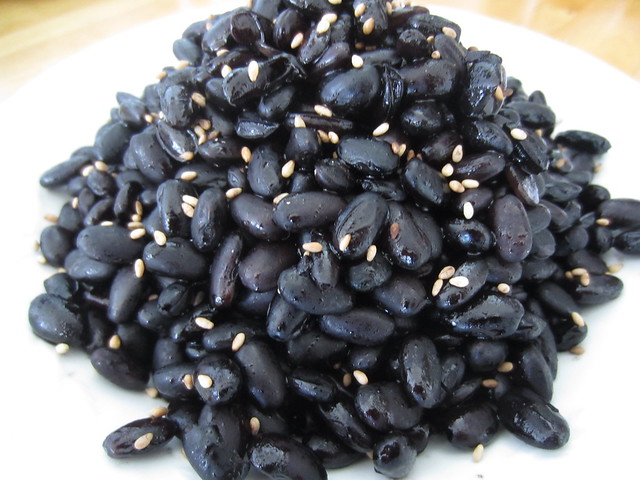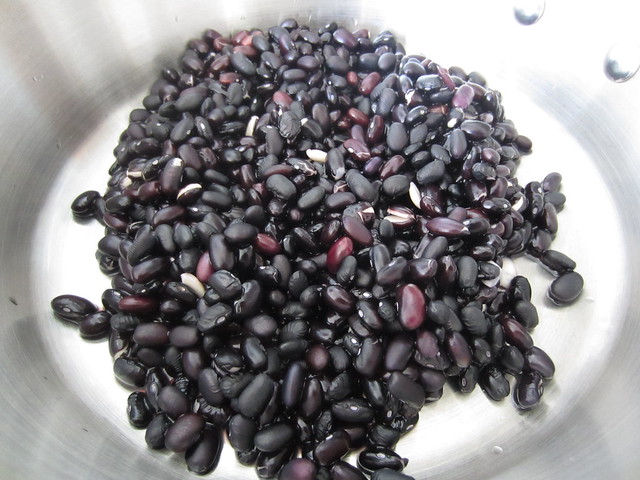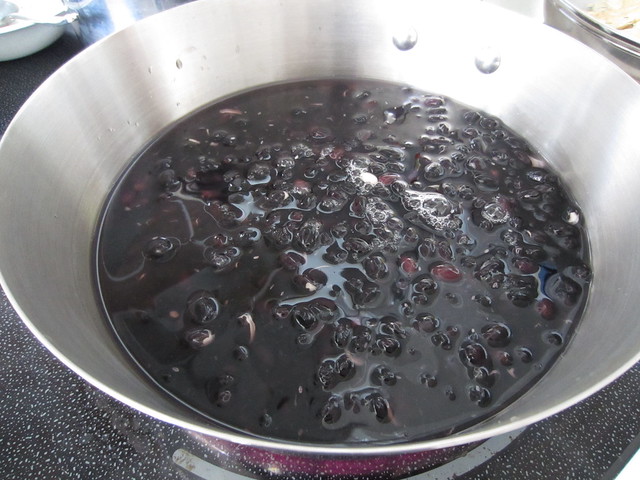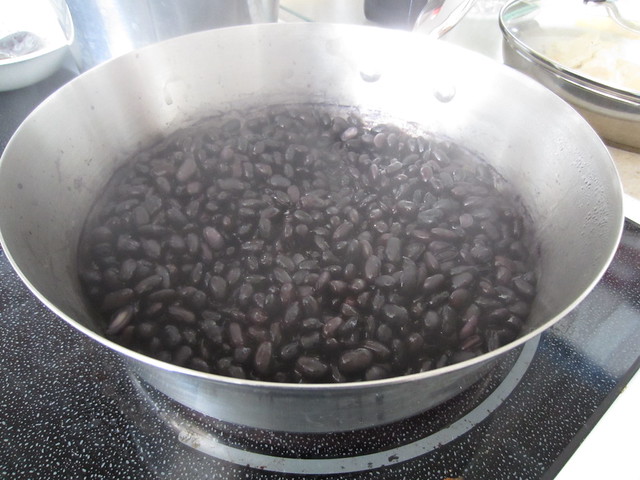You are here
How To Make Korean Black Beans
Per ounce, few foods on this planet can stand toe to toe with black beans and come out on top in overall health value. When prepared as a traditional Korean side dish to be eaten alongside steaming bowls of rice and soup, black beans are a longtime favourite in our home.
Sometimes called turtle beans, these black legumes offer a distinct, rich flavour and a velvety mouth-feel. The key is to avoid overcooking them. Cook them through so that they're edible, but be sure that they remain chewy.
The health-enhancing properties of black beans are numerous - we know that they're abundant in flavonoids that can help keep your heart and circulatory system healthy. They are also excellent for promoting and maintaining healthy flora in the digestive tract, which lowers risk of colon cancer.
However you prepare them, be sure to soak for a good few hours before cooking, as soaking helps remove phytates and tannins that your body can do without. Soaking also removes a naturally occurring substance called raffinose, which decreases flatulence potential.
How To Make Korean Black Beans
Ingredients:
1 cup black turtle beans
3 tablespoons soy sauce
1 teaspoon roasted sesame seeds
1 tablespoon honey
1 tablespoon sesame oil
Directions:
1. Wash beans well, then soak them in cold water for 5 hours.
2. Strain, then transfer beans to a cooking pot. Add enough cold water to cover beans.
3. Bring to a boil, then simmer for 20 to 25 minutes, stirring occasionally. No need to use a lid. Cook until beans are edible - you don't want them to be mushy soft; the goal is to cook them through but maintain a bit of chewiness.
4. Strain cooking water, then transfer cooked beans to a bowl. Add the rest of the ingredients, then toss well.
5. Garnish with another sprinkle of sesame seeds. Enjoy with steaming bowls of rice and soup!
If you'd like to print the ingredients and directions in this post without the photos, please cut and paste the following into your word processor of choice and print from there:
How To Make Korean Black Beans
Ingredients:
1 cup black turtle beans
3 tablespoons soy sauce
1 teaspoon roasted sesame seeds
1 tablespoon honey
1 tablespoon sesame oil
Directions:
1. Wash beans well, then soak them in cold water for 5 hours.
2. Strain, then transfer beans to a cooking pot. Add enough cold water to cover beans.
3. Bring to a boil, then simmer for 20 to 25 minutes, stirring occasionally. No need to use a lid. Cook until beans are edible - you don't want them to be mushy soft; the goal is to cook them through but maintain a bit of chewiness.
4. Strain cooking water, then transfer cooked beans to a bowl. Add the rest of the ingredients, then toss well.
5. Garnish with another sprinkle of sesame seeds. Enjoy with steaming bowls of rice and soup!
Join more than 80,000 readers worldwide who receive Dr. Ben Kim's free newsletter
Receive simple suggestions to measurably improve your health and mobility, plus alerts on specials and giveaways at our catalogue
Please Rate This
Highest RatedNo articles have been rated for usefulness recently, please check later. | Related Posts | ||
















Comments
I've been trying to get back
I've been trying to get back to eating more beans again. I actually have some dried black beans on hand, so I'm going to put them on to soak and will try this recipe tomorrow. Thanks!
Your black bean recipe!
I love black beans, so does my family. Of all the beans I've tried, only yellow-eyed peas are its equal. But the idea of putting a bit of honey in with them is new to me. I can't wait to try this, Ben.
One more thing...
I was heartened by your criticism of how so many folks go for the expensive, foreign food (or herb, too). If you want ultrahealthy, go into the forest and pick wild berries in your area, wherever you live. They will be at least as good for you. Just make sure you know what you are picking, make sure they are not poisonous.
Soak water
Firstly, thank you Dr.Ben! The information you provide is always very clearly written, with a no-nonsense, grounded approach, which I highly appreciate.
So, I've always wondered whether it was better to use the soaking water of beans to cook them in, but I think your article answered my question ( "soaking helps remove phytates and tannins, ... " ), so I'm guessing it's better to dump this water..
Does the same apply for rice?
Finally, does over-cooking beans (and rice) - to the point where it's mushy soft - result in a loss of further nutrients?
Finally (really), any thoughts on sprouting beans (and eating it raw, or cooking them post-sprouting)?
Thanks!
Korean Black Beans - Delicious!
Just made these, following the instructions to the letter. They are so delicious! The beans are tender with satisfying mouth appeal. And the sauce is delicate and savory. I really love it. I need healthy simple proteins to go to for breakfast and lunch and these are going to the top of my list. Wonderful!
Korean Black Beans
I'm eating your Korean black bean recipe as I type this. Delicious!!! But my husband wanted to know if it should be heated or eaten cold.
From Myra Bailes
Wow, and just think....black beans are THE protein staple in throughout southern Mexico and Guatemala. Around here I likely to eat black beans as often as every day of the week! You might want to share with your readers that the quality does make a difference--the more recently harvested the beans, the shorter the cooking time. And the fresher beans are going to have a better flavor, too. I remember that sometimes in the USA, I'd soak my beans all night, and then still have to boil them for two hours. Those must have been sitting way too long in the warehouse or at the market. But here, since everybody buys them all the time, the beans are fresh and only take an hour to cook.
Bean cookery here is diverse. We often eat them plain, in their own broth, with a dash of salt. Maybe the cook threw in a wedge of onion and a clove of garlic, or a sprig of epazote (a bitter herb that belongs to the beet family), and maybe a dried chile. Or, "refrito", refried. Although really frijoles refritos aren't fried twice. All you do is take the boiled beans and smush them up, either in a bowl with a masher, or in a very brief session in the blender, and then add them to the pan where you've been sauteéing some chopped onion, a bit of garlic, and maybe some chopped chile peppers. Let the bean liquid cook down until the beans are thick enough to stay on your fork or spread easily on your tortilla. Yum!!!! Refritos also serve as a filling for "antojitos" (little whims), the typical fried variations of the corn tortilla, such as gorditas, empanadas, garnachas, etc., and also the tamales de frijol, which are traditional to serve with mole (pronounced mol-eh) sauce.
If it weren't for the lamentable invasion of industrial junk food and drink--including easily-rancible cooking oils, mostly sunflower, safflower, and soy--, the Mexica diet would be a healthy one!
Best always,
Myra Bailes
Korean Black beans recipe
This recipe is a keeper, doc! So nourishing, so delicious and comforting to body and soul. Thanks for always emphasizing that our needs in food can be met with simplicity in ingredients and technique.
Very interesting and
Very interesting and informative comment, Myra!
korean black beans
Thank you Dr. Kim! I always pay attention to what you're teaching and I LOVE your recipes!! Will be making this one soon. Truly thanks for sharing your knowledge.